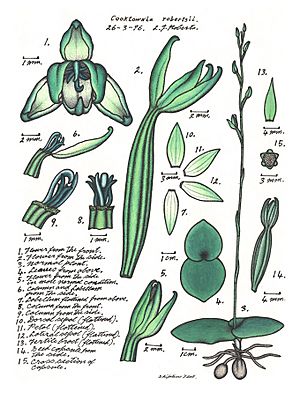Mystery orchid facts for kids
Quick facts for kids Mystery orchid |
|
|---|---|
 |
|
| Illustration by the discoverer: Lewis Roberts | |
| Conservation status | |
|
Least Concern (NCA)
|
|
| Scientific classification | |
| Genus: |
Cooktownia
|
| Species: |
robertsii
|
The mystery orchid, also known as Cooktownia robertsii, is a very special and rare plant. It's the only type of plant in its group, called Cooktownia. You can only find this orchid in far north Queensland, Australia. It grows on the ground and was named after Lewis Roberts, the scientist who first found it. This orchid has two leaves that lie flat on the ground and up to nine small green flowers. It's quite unusual because its flowers don't have pollen or a part that can receive pollen, which means it makes seeds in a unique way without needing another plant.
Contents
What the Mystery Orchid Looks Like
The mystery orchid is a plant that grows from a tuber (a swollen underground stem, like a potato). It's a perennial plant, meaning it lives for more than two years. It has two dark green leaves that are shaped like an egg or are almost round. These leaves lie flat on the ground. They are about 15 to 30 millimeters (0.6 to 1.2 inches) long and 10 to 30 millimeters (0.4 to 1.2 inches) wide. Their bases overlap each other.
Flowers and Stems
The orchid grows between three and nine green flowers. These flowers have darker lines on them. Each flower is about 7 millimeters (0.3 inches) long and 2.5 millimeters (0.1 inches) wide. They grow on a tall stem that is about 150 to 250 millimeters (5.9 to 9.8 inches) high.
The flower parts called sepals and petals are shaped like a spear or an egg. They are 6 to 7 millimeters (0.2 to 0.3 inches) long and about 2.5 millimeters (0.1 inches) wide. The labellum (which is a special lip-like petal) is about 7 millimeters (0.3 inches) long and 2.5 millimeters (0.1 inches) wide. Its edges are rolled inwards, and it doesn't have a spur (a hollow projection).
Reproduction and Life Cycle
The flowers of the mystery orchid are apomictic. This means they can form seeds without needing to be fertilized by pollen. They don't have pollen, and the part that usually receives pollen (the stigma) isn't able to do so. This unique way of making seeds happens between March and May each year.
How It Got Its Name
The mystery orchid, Cooktownia robertsii, was officially described in 1997 by a scientist named David Jones. He studied a plant sample that was collected in 1993.
Naming the Genus
The first part of its scientific name, Cooktownia, comes from Cooktown. This town in Queensland is the closest major place to where this special orchid is found.
Naming the Species
The second part of its name, robertsii, is a tribute to Lewis Roberts. He was the person who first discovered this orchid. He found it near his home in Shipton's Flat, close to Cooktown, back in the 1980s.
Where the Mystery Orchid Lives
The mystery orchid is only found in a small area south of Cooktown in tropical far north Queensland, Australia. Even though it's found in a very specific spot, it can be quite common in that area. It's also easy to grow and reproduces well. You can find it growing in open forests, usually in grassy spots. It prefers red, gravelly, or stony soil. It grows at altitudes (heights above sea level) of about 300 to 500 meters (980 to 1,640 feet). It grows best between March and late April.

